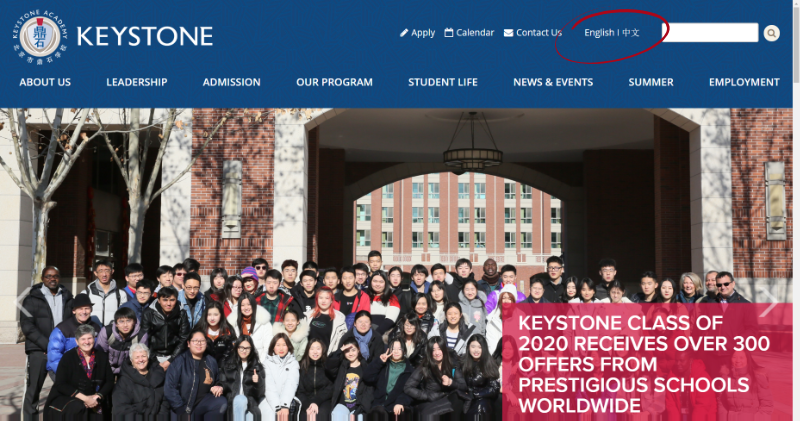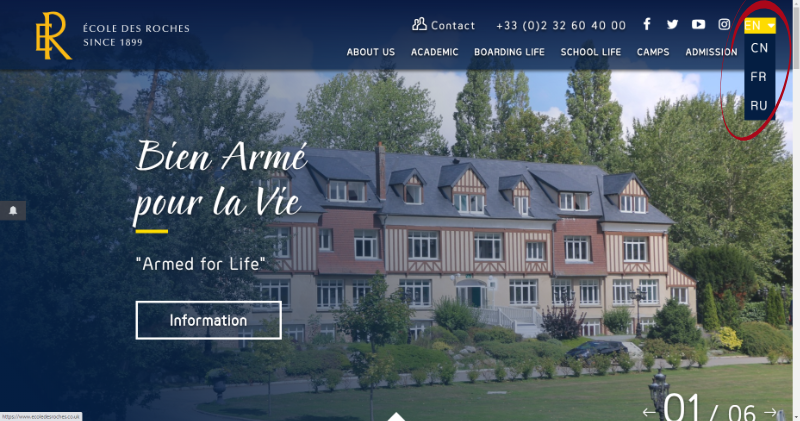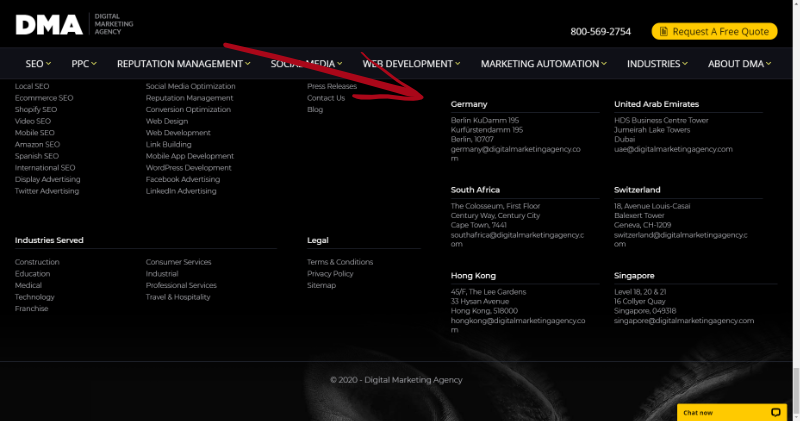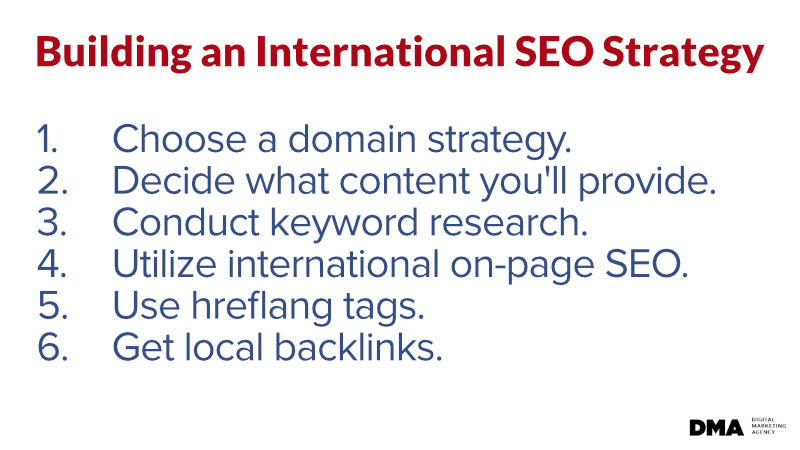SEO
Free SEO Analysis
SEO Services
Content Marketing Services
Local SEO
Link Building Services
Specialized SEO Services
PPC
REPUTATION MANAGEMENT
Free Reputation Management Analysis
Reputation Management Services
Review Management Services
Specialized Reputation Management Services
CEO Reputation Management
Brand Enhancement
Business and Directory Listings
Comprehensive Reputation Management Audit
SOCIAL MEDIA
Free Social Media Analysis
Specialized Social Services
WEB DEVELOPMENT
Free Website Analysis
Web Design Services
Mobile Development Services
Website Maintenance Services
Specialized Development Services
MARKETING AUTOMATION
Free Marketing Automation Analysis
Specialized Marketing Automation Services
Comprehensive Marketing Automation
INDUSTRIES
ABOUT DMA
SEO
6 Tips to Create an Effective International SEO Strategy
Request a quote
Its Fast, Easy & Free
Executive Summary
- With 93% of the world’s internet users living outside of the U.S., international SEO is a great way to grow your business.
- Being successful at international SEO means understanding sometimes nuanced differences in culture, language, and search habits of the international markets you’re trying to reach.
- International SEO starts with a solid understanding of the needs of your international customers. Then, you can start optimizing and customizing your content and site to their needs.
Did you know that 93% of the world’s internet population is located outside of the United States? Still, many U.S. companies and small businesses don’t engage in global trade.
If you’re targeting only potential customers in the U.S., you’re missing a lot of opportunities for international sales.
But how do you even take your business global? Isn’t it prohibitively difficult to do?
Going global seems big, scary, and complicated, but it doesn’t have to be. In this article, we’ll share six tips that will help you jumpstart your international SEO.
What Is International SEO?
International SEO is the process of optimizing your online presence for people outside of the U.S. and who speak different languages from English.
You can use geotargeting, hreflang tags, and other localization signals to target users everywhere.
Google already tries to match search results to the location and language of the searcher. When you add localization signals to your website, it helps search engines know that the content on your site will work for certain geographies or languages.
Why Does International SEO Matter?
With 93% of the world’s internet users living outside of the U.S., international SEO is a great way to grow your business.

If your business has global appeal (eCommerce, website design, digital marketing, and more), international SEO might be right for you. International SEO gives you a chance to bring your products and services to anyone, anywhere.
Plus, an effective international SEO strategy can help you gain market share by focusing on markets that your competitors aren’t looking at.
6 Tips for an Effective International SEO Strategy
No SEO strategy is one-size-fits-all. This seems to be especially true for international SEO.
Being successful at international SEO means understanding sometimes nuanced differences in culture, language, and search habits of the international markets you’re trying to reach.
If you want to jump into international SEO quickly and easily, the best way to do that is with Digital Marketing Agency. We offer international SEO services in 82 languages to help you reach a growing international audience through a multilingual SEO strategy.
Whether you hire a digital marketing agency experienced with international SEO or decide to go it alone, here are six international SEO tips that will get you started.
1. Choose a Domain Strategy
Your current .com domain extension is highly lauded by search engines but doesn’t do much to let international customers know that your products and services are for them, too.
Your domain needs to target the country you’re trying to reach.
You can do this with a country-code domain (ccTLD). These domains look like “domain.cc,” ending with a two-character country code.
Fortunately, when you have localized versions of a website across ccTLDs, search engines will treat each site as a separate entity. However, this also means that backlinks will need to be built for each site, and each site’s authority starts at nothing.
There are other domain options, too.
Some businesses use a subdirectory for each country they’re targeting (domain.com/cc). This domain strategy will let you maintain your current SEO efforts.
Of course, if you’re creating the same content in the subdirectory it could cause keyword cannibalization as different landing pages are optimized and competing for the same keywords.
Other businesses use a subdomain to differentiate the countries they’re trying to reach (cc.domain.com).
Subdomains seem to be the default for many CMS tools, but your international users might not see associate your site with their country since the country code isn’t where they’re used to seeing it.
We recommend checking the domain structures of your competitors in the countries you’re targeting to see what works the best.
You may find yourself using a combination of domain strategies, depending on where in the world you want to go.
What About Non-English Characters in URLs?
You’re not required to use English characters in URLs. In fact, excluding special characters, you can use characters from any language, like Chines, Russian, Arabic, Japanese, and more.
We strongly encourage you to use non-English words and URLs for non-English websites.
2. Decide What International Content to Provide
How are you going to optimize for search results? You can optimize based on geography, language, or both!
Sites like that for China’s Keystone Academy are automatically optimized for Chinese and English, but the site also offers visitors the change to toggle between the two languages:

École des Roches is another site that lets you choose your language:

There are also sites that provide a completely different site for customers depending on where they are.
As you can see, international SEO can range from translating your site into a different language to creating a complete, customized experience for each country you’re targeting.
You may be wondering how you can decide what method to use.
A great place to start is by checking your analytics to see where your traffic is coming from. If you’re getting a lot of traffic from countries you haven’t optimized for, those are good opportunities to tackle.
3. Keyword Research for International SEO
Keyword research is the same across the board. However, be sure to have your keywords professionally translated—don’t just drop them into Google Translate and hope that it’s accurate.
Remember, every country has its own culture and search habits. When you get your keywords professionally translated, you won’t end up with a bad translation that could tank your international SEO efforts.
After you’ve had your keywords translated, you’ll plug the keywords into your favorite keyword research tool to find out search volumes, competitors, and the other information you’ll need to plan out your content.
Keyword research for international SEO means that many of the keywords related to the ones you’re looking up won’t make sense to you. That’s okay.
This is where a tool like Google Translate will come in handy. Since you’ve already had your keywords professionally translated, you can use a translation tool to find out if the related keywords that come up are truly relevant to the audience you’re trying to reach.
Before you’re done with your international SEO keywords, you’ll want to do competitor analysis.
Most keyword research tools let you enter the URL from a competitor so you can find out which keywords are performing best for them. Then, use a translation tool to find out if those keywords might work for you.
4. International On-Page SEO
Your international pages should be entirely in the target language. This means that you’ll be spending time with on-page SEO to ensure that all of your on-page elements are correct.
Having multiple languages on a single page sends confusing signals to both search engines and your site visitors, sending rankings and trust spiraling.
You should include your translated keywords naturally in these on-page elements:
URL
Page title
Meta description
Header and subheadings
Page content
Images: file names, words in images, and the image alt-text
Anchor text for internal linking
Navigation
Additionally, if you have a local phone number and address, you should include those in the footer. Here’s what that looks like on our homepage:

Your on-page elements should be professionally translated, too.
If you’re looking for an SEO agency that can provide full-service international SEO services, including translation, Digital Marketing Agency can help!
5. Use Hreflang Tags for Language Targeting
Okay, bear with us, it’s going to get a little technical for a minute.
Hreflang tags are code snippets used on websites with multilingual content. They let search engines know that another language is in play and help them match the language to the person searching.
Using hreflang tags means that Arabic speakers would see your Arabic content instead of your English content, for instance.
Google looks at the terms a searcher uses, the user’s search history, settings, and the Google domain that’s being used to help them decide the preferred language of a user.
You should use hreflang tags if you are using subdirectories or subdomains as part of your domain strategy. They aren’t needed if you’re using ccTLDs, but you can use them to potentially improve the location signal.
Even though search engines can usually figure out the language on a page without hreflang tags, the tags will keep your different pages from competing for the same search terms.
How to Use Hreflang Tags
If you choose to use hreflang tags, there are a few things you need to know.
For starters, hreflang tags can include both mandatory and optional components. Language codes are mandatory, while country codes are optional.
Hreflang tags are formatted as hreflang=”languagecode-countrycode.” So, to target English speakers in the U.S., you’d use “en-US,” but for Spanish speakers in the U.S., you’d use “sp-US.”
You can use hreflang tags in the source code on the header of each page, in the HTTP header on each page, or in your sitemap. Pick the options that’s easiest for you to maintain, but use the same method across your site.
6. Use Local Link Building
Link building is vital to building the authority of your site. That means you’ll need to find local influencers and businesses to connect with and start building relationships.
This can be hard for businesses with products and services that have global appeal but that don’t have a local presence. Not only are there time differences to battle, but you also might not know the language or cultural nuances of the country you’re targeting.
Once again, having an SEO agency that deals with international SEO and uses in-house translators will be a benefit to you.
We recommend looking for opportunities to share your expertise, through guest posts on high-authority sites and using social networks to build connections in your target region.
Get Started With International SEO

International SEO starts with a solid understanding of the needs of your international customers. Then, you can start optimizing and customizing your content and site to their needs.
With the tips in this article, you’ll be able to get started with international SEO quickly and start reaching potential customers on a global scale.
Of course, international SEO has a lot of moving pieces. It can get expensive and takes a lot of resources that you might not have at your disposal.
Does that mean international SEO isn’t possible for you? No. It just means that you need to start small and increase your efforts over time.
Or, you can get started with international SEO today with Digital Marketing Agency. Contact us for a free quote!
Our Sales team